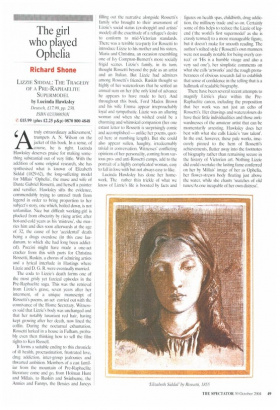The girl who played Ophelia
Richard Shone
LIZZIE SIDDAL: THE TRAGEDY OF A PRE-RAPHAELITE SUPERMODEL by Lucinda Hawksley Deutsch, £17.99, pp. 230, ISBN 023300050X (t £15.99 (plus £2.25 p&p) 0870 800 4848
truly extraordinary achievement,' trumpets A. N. Wilson on the jacket of this book. In a sense, of course, he is right. Lucinda Hawksley deserves praise for making something substantial out of very little. With the addition of some original research, she has synthesised what is known of Elizabeth Siddal (1829-62), the long-suffering model for Millais"Ophelia', the muse and wife of Dante Gabriel Rossetti, and herself a painter and versifier. Hawksley sifts the evidence, commendably trying to unravel truth from legend in order to bring proportion to her subject's story, one which, boiled down, is not unfamiliar. Nice but difficult working-girl is plucked from obscurity by rising artist; after hot-and-cold years as his 'mistress', she marries him and dies soon afterwards at the age of 32, the cause of her 'accidental' death being a drugs overdose (in this case laudanum, to which she had long been addicted). Puccini might have made a one-act cracker from this with parts for Christina Rossetti, Ruskin, a chorus of admiring artists and a lyrical interlude in Hastings where Lizzie and D. G. R. were eventually married.
The coda to I izzie's death forms one of the most grisly yet farcical episodes in the Pre-Raphaelite saga. This was the retrieval from Lizzie's grave, seven years after her interment, of a unique manuscript of Rossetti's poems, an act carried out with the connivance of the Home Secretary. Witnesses said that Lizzie's body was unchanged and that her notably luxuriant red hair, having kept growing after her death, now lined the coffin. During the nocturnal exhumation, Rossetti lurked in a house in Fulham, probably even then thinking how to sell the film rights to Ken Russell.
It forms a suitable ending to this chronicle of ill health, procrastination, frustrated love, drug addiction, inter-group jealousies and thwarted ambition. Members of a cast familiar from the mountain of Pre-Raphaelite literature conic and go, from Holman Hunt and Millais, to Ruskin and Swinbume, the Annies and Fannys, the Bessies and Janeys filling out the narrative alongside Rossetti's family who brought to their assessment of Lizzie's social status (ex-shopgirl and artists' model) all the exactitude of a refugee's desire to conlOrm to mid-Victorian standards. There was a terrible tea-party for Rossetti to introduce I Azzie to his mother and his sisters, Maria and Christina, an occasion resembling one of Ivy Compton-Burnett's more socially frigid scenes. Lizzie's family, in its turn, thought Rossetti beyond the pale as an artist and an Italian. But Lizzie had admirers among Rossetti's friends. Ruskin thought so highly of her watercolours that he settled an annual sum on her (the only kind of advance he appears to have made to her). And throughout this hook, Ford Madox Brown and his wife Emma appear irreproachably loyal and sympathatic. Lizzie was an alluring woman and when she wished could be a charming and whimsical companion (her one extant letter to Rossetti is surprisingly comic and accomplished — unlike her poems, quoted here at numbing length). But she could also appear sullen, haughty, irredeemably trivial in conversation. Witnesses' conflicting opinions of her personality, coming from various proand anti-Rossetti camps, add to the portrait of a highly complicated woman, easy to fall in love with hut not always easy to like.
Lucinda Hawksley has done her homework. The rather thin trickle of what we know of Lizzie's life is boosted by facts and figures on health spas, childbirth, drug addiction, the millinery trade and so on. Certainly some of this helps to reduce the Lizzie of legend ('the world's first supermodel' as she is crassly termed) to a more manageable figure, but it doesn't make for smooth reading. The author's stilted style (Rossetti's own manners were not usually notable for being overly correct' or 'His is a humble visage and also a very sad one'), her simplistic comments on what she calls 'artworks' and the rough protuberances of obvious research fail to establish that sense of confidence in the telling that is a hallmark of readable biography.
There have been several recent attempts to magnify Lizzie's place within the PreRaphaelite canon, including the proposition that her work was not just an echo of Rossetti's. I ler drawings and watercolours do have their little individualities and those awkwardnesses of the amateur artist that can be momentarily arresting. Hawksley does her best with what she calls Lizzie's 'raw talent'. In the end, however, these pale works, insecurely pinned to the hem of Rossetti's achievements, flutter away into the footnotes of biography rather than remaining secure in the history of Victorian art. Nothing Lizzie did could overtake the lasting fame conferred on her by Millais' image of her as Ophelia, her flower-strewn body floating just above the water, while she chants 'snatches of old tunes/As one incapable of her own distress'.


















































































































 Previous page
Previous page